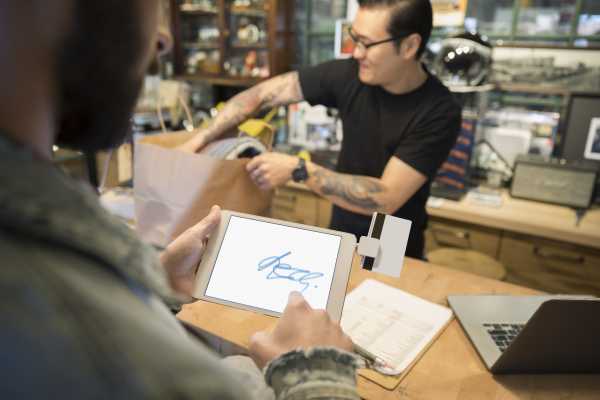

This April, several major credit card networks made a wild decision: They would no longer require customers to sign receipts.
“Credit card networks are finally ready to concede what has been obvious to shoppers and merchants for years: Signatures are not a useful way to prove someone’s identity,” announced the New York Times, citing a long anecdote about a man who has, for years, been “signing” his receipts with “a doodle of a dog wagging its tail.” It has caused him no problems.
When four of the largest networks — American Express, Discover, Mastercard, and Visa — announced they would stop requiring signatures, it was both an acknowledgment of reality and a declaration of progress. Signatures don’t actually prevent fraud; now we have better technologies that do.
Yet I am still asked to sign constantly. I have signed for non-medicated cough drops. I have signed for takeout soup. I have signed for ingredients to make my own soup. So why, if we have all agreed that signing does not successfully confirm my identity, am I still signing all the time?
The rise of the credit card signature
The history of the modern credit card dates back the 1920s. The history of the signature as a means of validating a contract, though — and what is a receipt but a miniature contract? — goes back much further. As Talmudic scholar Rabbi Pinchas Allouche explained to Planet Money, the Talmud explicitly specifies that signatures are required to legitimize a contract.
And not only signatures but specifically legible signatures. Consider a marriage contract, which, by Talmudic law, must be signed by the couple as well as by witnesses, who could vouch for the fact that the marriage had taken place. What good is a signature if you can’t later go back and track down the person who signed?
A marriage contract is not exactly equivalent to the contract you are signing when you confirm that yes, this cafe did serve you a cup of coffee, and yes, you did pay $2.50 for it. But the Talmud does not make this distinction: “The law that applies to one cent is the same law that applies to 1,000 gold coins,” Allouche says. So: sign for your marriage, sign for your latte.
The world is not governed by Talmudic law. But the role of the signature has not changed all that much: it is a mark confirming that you are you, and that your purchase is being made with your consent. And as Planet Money points out, a signature was a pretty effective way to do that, so it became a cultural default, a way of doing business. It stayed that way through the rise of the personal check (which required a signature) and the credit card (which required a signature): Yes, it is me. Yes, I meant to do that.
But the problem with signatures as verification, Planet Money observes, is that they only work if somebody is actually verifying it. “In theory, the merchant was supposed to be looking at the signature that you give at the point of sale and comparing it to the signature on the back of your card,” Ted Rossman, an industry analyst at CreditCards.com, tells me. “It was really intended to be a security thing.”
The security is not just for you. “The bottom line is the signature was to protect the lender from fraudulent use,” Robert D. Manning, currently chair of the department of management at Prince Muhammad University in Saudi Arabia and author of the book Credit Card Nation, says when I reach him by phone. In other words: If you were charged and you disputed the charge, there was a paper trail. Had you signed?
Because if you hadn’t, or someone else had, the responsibility fell not to the cardholder or to the bank that had issued the card, but to the merchant, who was supposed to be checking that sort of thing.
Did signatures ever really work for preventing fraud? I ask Rossman, who seems skeptical. “For the most part, it really didn’t. That’s a big part of why all the networks recently did away with signatures,” he tells me. Less than preventing crimes, signatures were useful for adjudicating blame.
As Mastercard’s Carolyn Balfany told Planet Money, the primary role of signatures, in recent years, was to exist, just in case someone complained. And while she said it would not be ideal if that signature was, say, a doodle of a schnauzer, there are no particular consequences to a non-signature signature, except possible awkwardness should the dispute process escalate.
The slow death of the credit card signature
The death of the signature is not so much an acute cardiac event as a slow decline — one led, Manning says, by merchants themselves. The problem with signatures, besides general inefficacy, is that they are cumbersome (merchants have to store their copies somewhere) and slow. For smaller transactions, he says, it made more sense for merchants to eat the occasional cost of a disputed transaction than to slow down the line.
“The fast-food industry was clamoring to have swipe-based, non-signature-based transactions, because [signing] was slowing down the line. Even if it was as little as 30 seconds, you multiply that by hundreds of people, and it was a huge cost savings for them in terms of manpower,” he says. And so a threshold emerged: Starting around 2010, according to the Times, credit card networks stopped requiring signatures on purchases under $25 or $50, although it was up to individual merchants whether to take advantage of the revised policy.
Many did not. “The jumble of rules about which transactions required signatures and which did not — every issuer has its own policies — discouraged many merchants, especially smaller ones, from scrapping signatures altogether,” explained the Times.
And then came April 2018, when Mastercard, Visa, American Express, and Discover agreed they would no longer require signatures at the point of any sale. (The rules of each network are slightly different: Visa doesn’t require signatures in North America, but only for merchants with payment systems that read chip cards; Mastercard is ditching signatures, but only in the US and Canada.)

“The change is part of Discover’s efforts to continually improve the payment experience by speeding up the time spent at checkout all while maintaining a high level of security for both customers and merchants,” a representative for the company wrote me (by email, no signature), citing a number of “digital authentication technologies” that have replaced our indistinguishable scribbles. “With the rise in new payment security capabilities, like chip technology and tokenization, the time was right to remove this step from the checkout experience.”
Until relatively recently, the US checkout experience was not good. You might even say it was bad; at Vox, Timothy B. Lee termed it “old and busted.” Until 2015, in the US, you made in-person credit card purchases by swiping a magnetic strip on your card, which, Lee explains, contains “a machine-readable version of the same information that’s printed on the card itself: the account number, account holder’s name, and the card expiration date.” But this meant you were sharing your data with everyone, all the time. Here’s Lee again:
Eventually, the US caught on to what Europe and Asia already knew, and transitioned away from strips to chips. Chip cards, the current standard, contain a tiny computer chip that creates a one-off code for every transaction. But while other countries use “chip and PIN” technology, which pairs the chip with a debit card-esque personal identification number, the US transitioned to a chip-and-signature system. We just love signing things here; after football, it is our national pastime.
Tokenization, meanwhile, is what happens when you use something like Apple Pay, which instead of using your actual credit card number creates a “string of seemingly nonsensical letters and numbers” representing your credit card number, NerdWallet explains. It is drastically more secure than signing your name.
So why are you still constantly signing things?
The fact that several major credit card networks no longer require signatures — and the fact that more and more shopping is happening online, where signatures are not required anyway — has not changed the reality that a lot of us are still signing a lot of receipts. Small receipts, even!
I bring my concerns to Discover (I do not have a Discover card). “Keep in mind that while Discover does not require signatures anymore, merchants may decide to still require one when customers are checking out,” the rep tells me, adding that if merchants want to transition away from signatures, they “may need to update their point of sale systems.”
Is the answer to this mystery that my merchants just haven’t updated their sale systems yet? “The vast majority of merchants have gone along with the networks and said no more signing,” Rossman says, with one categorical exception: bars and restaurants, which still commonly ask for signatures. “You’re leaving a tip that changes the bill,” which, he says, is “different than signing for something with a fixed price.” The fact that you’re changing the total after the fact is “a big part of why they still want you to sign.”
He points me to an article about high-concept dine-and-dashers, who specifically don’t sign restaurant receipts and then dispute the charges later. About half the time, he says, people get away with it. (Rossman stresses that this is still a bad idea, because of ethics.)
If you forget to sign, though, probably nothing bad will happen to you. “I think the key here is whether or not you dispute it,” he assures me. “If you just forget to sign it, chances are everything will go through just fine. If you wrote a tip on the card, it should get processed. Your card should get billed. Everything should be totally legit.” This is soothing, in a way, but also underscores the futility of signatures.
It’s possible, Rossman speculates, that they could be useful in other ways: Some merchants “may have had instances of fraud,” he suggests. “Or they just want to be careful.”
He tells me that while chip technology has ushered in the post-signature age, the real future is most likely in biometrics. “I think we’re already seeing some nudges in this direction with things like Apple Pay,” which uses touch or face ID, depending on the model of the phone. Visa is currently piloting a biometric payment card that recognizes your fingerprint. “That’s really where payments are headed,” he says.
Until then, we will continue to sign, whatever that means: a name, a line, a picture of a dog.
Sourse: vox.com






